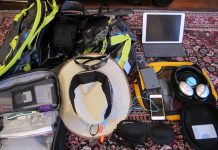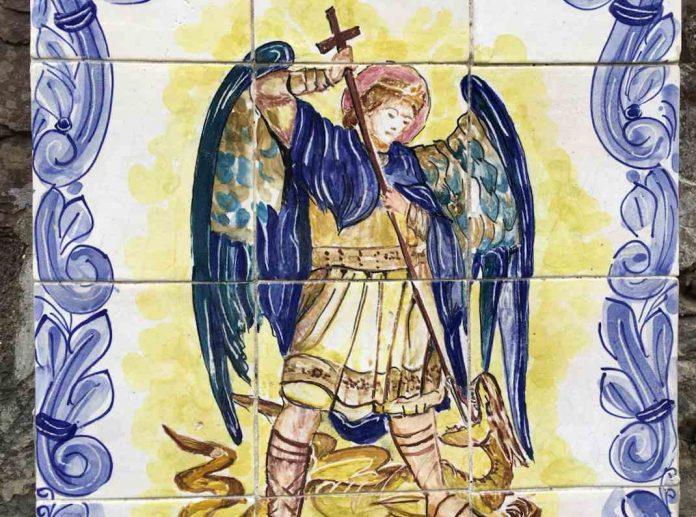Colonia del Sacramento is an old Colonial town originally founded in 1680 by the Portuguese, but with some Spanish influences (the town flip-flopped between the two at least 8 times hands a few times during its history). Built on a peninsula into the Rio de la Plata river, it was a walled settlement that has been designated a UNESCO World Heriage Site. It hosts many small museums, and enought attractions to fill the better part of a day trip.
My recommended day tour from Buenos Aires:
Take the BuqueBus ferry across from BA. I took the 8:15a boat and arrived about 9a.
Stop at the information booth in the center of the arrival hall. They can provide an overview of the attractions, and a helpful map of the area.
Pick up some Uruguayan Pesos from the ATM or the Bank/money exchange, but don’t get too much. You won’t need much for the day, and US Dollars and Argentine Pesos can also be used.
Rent a bike from the Thrifty booth before leaving the arrival hall. The cost is $4.92/hour or $14.75 for the rest of the day, providing that you pay with a credit card (the cost is slightly more for cash, and slightly less if you use American Express). You can start renting by the hour and pay the day rate if you go over three hours. They provide a lock, and they strongly recommend that you lock the bike *to* something, not just to itself. The bike has a small basket up front, which makes you look like a little old lady going grocery shopping, but it turned out to be very practical for me.
Note: You can rent from the arrival hall, and turn the bike in at their downtown office; but then you would have walk back to the port. Or you can walk into town, rent from their office there and drop it off at the port on your return.
Note 2: You can also rent scooters, ATVs, and electric “Classic Cars” (which look like model T’s) but then you’ll have to worry about finding parking spots and you won’t be able to eat that big slice of desert later that you’ll be burning the corresponding caleries from while riding your bike.
At the north west corner of the port parking lot, you will find a glass-walled tourist information center (BIT). Take a few minutes to step inside and ask to watch “the film”. It is a 360 degree visual experience of the many wonderful things to see in Uruguay. There is no verbal audio, and no real beginning and ending, so you don’t have to wait for the start. Just walk up and down a bit (there are no seats) and whet your appetite for some more adventures in Uruguay.
Leaving the BIT, follow the path immediately to your right which will take you along the water. When it curves to the right, continue north on Washington Barbot street, and then take a left on Manuel Lobo Street. This will lead you to the Porton de Campo (main gate). After taking pictures (you are taking pictures, arn’t you?) and passing through the gate, take an immediate left on Paseo de San Miguel. Then take a right at the end of that street (it dead ends) onto De San Pedro street. Note the city walls which you will want to come back and view. On De San Pedro you will pass Calle de los Suspiros (Street of Sighs) which you will also want to get back to, but first we are on a mission. Three blocks down you can’t miss the Lighthouse on the right.
The lighthouse ($1 US) is a great place to start your tour, not only will the high vantage point help you get your bearings, but if you are lucky, you’ll get there before the crowds. Once many people arrive, the single winding staircase becomes a major chokepoint. Once enough people arrive, they post an employee at the first landing, who with a walkie-talkie connection to someone downstairs, is able to direct the up and down traffic… but it still slows your exit tremendously.
If it is still before 11:15a, then wander around the Plaza Mayor a bit and enjoy the atmosphere, or head back to see the wall and Calle de los Suspiros. The rush is off, now that you have experienced the lighthouse, and you can relax a bit.
At 11:15a, the Museo Municipal Museum opens. It is just steps from the lighthouse at the western end of Plaza Mayor and is the next stop since it sells a ticket which will get you into itself and most of the other museums. I use the term “museum” very loosely. They are mostly one or two rooms with signs almost exclusively in Spanish. You can get the gist of the content though (bones have pictures of the animals from which they came, etc.)
Check the map you got from the information booth at the port to find the other museums in the old town.
After seeing the 3-4 museums, head to the Plaza de Toros. It’s about 12 miles one way, but there are very few hills and the path takes you along the beach road. Head north past the stadium along the beach road until you see a fork onto Juan Manuel Caballero street. Take the right fork. If you have any difficulties, you should be able to get directions from anyone by simply saying “Toros?”. The bull ring is interesting enough to venture to see, and since you have the whole day, you may as well enjoy the beach drive and come, but it’s only about 100 years old, and you can only see it from outside a fence about 20 feet outside it’s perimeter. There is also a museum dedicated to train cars there, although there’s an additional charge for it.
I suggest skipping the hypodrome. It’s been converted into a modern race track, with nothing worth seeing.
On your ride back, stop by the Museo Paleontologico. As you are facing the main entrance to the bull ring, take the third spoke (as you go around counter-clockwise) onto Rio de La Plata to get to the museum. It’s only two rooms, but the proprietor was very nice, and went to lengths to answer questions. The most interesting exhibit is of the shell-like (actually pourus bone) back bone of the Coraza de Gliptodonte, a turtle looking creature related to modern sloths, armadillos and anteaters. They have only been discovered in Uruguay and parts of Argentina.
To get back to town, continue on the same road and just after the road bends to the right you will find an old Catholic Church on the right (Iglesia de la Nueva Era).
Continue on the same road and when you get to a larger intersection with a large gas station on the far right, turn right to bring you back to the beach road you took to the bull ring. Now head back into the old town and find a place to eat.
After lunch, head to the Basilica del Santisimo, and thenwander around and enjoy the rest of the old town. It’s really quite small, so you can see all of it during the rest of the afternoon.
If you are on the 17:01 ferry back to Bs As, then make sure you get back to the port by 4pm to give yourself plenty of time to wait in the ticket, security, Uruguay customs and Argentinian customs lines.
The following two links will open maps to show you the path taken by the above itinerary:
| MAP 1 – Path to the Bull Ring | Map 2 – Path back from the Bull Ring |
![]()
Put the lighthouse first on your itinerary. It opens before the museums, and once it starts to fill up, your upward and downward mobility is *greatly* reduced.
 Why go?
Why go?
- Colonia del Sacramento is a lovely colonial town, set on the water, with an interesting back story, and plenty to see.
- The ferry ride over is fun, and short enough to hold your attention.
- It makes a great day trip from Buenos Aires, if you are looking to fill a day with something different.
 What you need to know:
What you need to know:
- Tour guides from the info center cost 200 URU. But if you follow up itinerary above, you won’t need one.
- Purchase a museum ticket from the Museo Municipal for 50URU. This will get you into it and most of the other museums. It opens at 11:15a.
- You can only visit each Museum once with the combined ticket, though I doubt this will be a problem (there’s not that much to see in each).
- If you pay in restaurants with a credit card, you get an 18%(ish) discount. This is provided by the Uruguayan government, and only applies to restaurants.
- Get to the lighthouse as early as possible. It opens before the museums, and gets crowded. Once it gets crowded, the single staircase becomes a major bottleneck.
- You can get to and around the old town very easily without a bike, but you will need transportation to visit the Bull Ring and the Museo Paleontologico, so you may as well get one for the day and see much more.
- The tourist information booth in the middle of the arrival hall at the port is a great source of information and of maps.
The historic tile sign at the base of the lighthouse.
.
Location: Colonia del Sacramento, Uruguay
.
The light house was built in 1857 on top of the ruins of the San Francisco convent. The cost to climb to the top is a mere $1 (US), but you want to get there early, or you`ll have to contend with waiting to use the single staircase.
.
This picture is posted on Instagram as a way to include it in my travel blog. Head to the link in my profile for more details: @mytravels.hdf
.
Picture taken: 01/2019
.
#farodecolonia #coloniadelsacramento #coloniadelsacramentouruguay #faro #colonia #uruguay
The lighthouse, Colonia del Sacramento
.
Location: Colonia del Sacramento, Uruguay
.
The light house was built in 1857 on top of the ruins of the San Francisco convent (the ruins can be seen in this picture). The cost to climb to the top is a mere $1 (US), but you want to get there early, or you`ll have to contend with waiting to use the single staircase.
.
This picture is posted on Instagram as a way to include it in my travel blog. Head to the link in my profile for more details: @mytravels.hdf
.
Picture taken: 01/2019
.
#farodecolonia #coloniadelsacramento #coloniadelsacramentouruguay #faro #colonia #uruguay #colonialtown
The (not particularly polite) staff member who helps to control upward and downward travel on the single staircase of the lighthouse.
.
Location: Colonia del Sacramento, Uruguay
.
Once more than a hand full of people visit the lighthouse, they position a staff member halfway up to regulate the flow of people on the narrow stairway.
The light house was built in 1857 on top of the ruins of the San Francisco convent (the ruins can be seen in this picture). The cost to climb to the top is a mere $1 (US), but you want to get there early, or you`ll have to contend with waiting to use the single staircase.
.
This picture is posted on Instagram as a way to include it in my travel blog. Head to the link in my profile for more details: @mytravels.hdf
.
Picture taken: 01/2019
.
#farodecolonia #coloniadelsacramento #coloniadelsacramentouruguay #colonia #faro #uruguay
The hatch you have to squeeze through to get to the top of the lighthouse.
Location: Colonia del Sacramento, Uruguay
.
The light house was built in 1857 on top of the ruins of the San Francisco convent (the ruins can be seen in this picture). The cost to climb to the top is a mere $1 (US), but you want to get there early, or you`ll have to contend with waiting to use the single staircase.
.
This picture is posted on Instagram as a way to include it in my travel blog. Head to the link in my profile for more details: @mytravels.hdf
.
Picture taken: 01/2019
.
#farodecolonia #coloniadelsacramento #coloniadelsacramentouruguay #colonia #uruguay
Me, on top of the lighthouse, Colonia del Sacramento
.
Location: Colonia del Sacramento, Uruguay
.
The light house was built in 1857 on top of the ruins of the San Francisco convent. The cost to climb to the top is a mere $1 (US), but you want to get there early, or you`ll have to contend with waiting to use the single staircase.
.
This picture is posted on Instagram as a way to include it in my travel blog. Head to the link in my profile for more details: @mytravels.hdf
.
Picture taken: 01/2019
.
#farodecolonia #coloniadelsacramento #coloniadelsacramentouruguay #uruguay #lighthouse #greenshirt #happytobealive #happytobealive❤️
Looking straight down from the lighthouse, Colonia del Sacramento
.
Location: Colonia del Sacramento, Uruguay
.
The light house was built in 1857 on top of the ruins of the San Francisco convent (the ruins can be seen in this picture). The cost to climb to the top is a mere $1 (US), but you want to get there early, or you`ll have to contend with waiting to use the single staircase.
.
This picture is posted on Instagram as a way to include it in my travel blog. Head to the link in my profile for more details: @mytravels.hdf
.
Picture taken: 01/2019
.
#farodecolonia #farodecoloniadelsacramento #coloniadelsacramento #coloniadelsacramentouruguay #uruguay #faro #sanfranciscoconvent
Plaza Mayor and beyond in Colonia del Sacramento
.
Location: Colonia del Sacramento, Uruguay
.
This is a view from the lighthouse. It captures the small area taken up by the town and shows the beach in the distance.
.
This picture is posted on Instagram as a way to include it in my travel blog. Head to the link in my profile for more details: @mytravels.hdf
.
Picture taken: 01/2019
.
#plazamayor #plazamayorcolonia #coloniadelsacramento #coloniadelsacramentouruguay #uruguay #lighthouse
The lighthouse in Colonia del Sacramento.
.
Location: Colonia del Sacramento, Uruguay
.
This should be your first stop on your tour of the town. See my blog for the reason.
.
This picture is posted on Instagram as a way to include it in my travel blog. Head to the link in my profile for more details: @mytravels.hdf
.
Picture taken: 01/2019
.
#colôniadelsacramento #coloniadelsacramento #coloniadelsacramentouruguay #lighthouse #tourcoloniadelsacramento #uruguay
Calle de los Supiros (Street of Signs)
.
Location: Colonia del Sacramento, Uruguay
.
One of the oldest streets with the original cobblestones.
.
This picture is posted on Instagram as a way to include it in my travel blog. Head to the link in my profile for more details: @mytravels.hdf
.
Picture taken: 01/2019
.
#coloniadelsacramento #calledelossuspiros #coloniadelsacramentouruguay #streetofsighs #cobblestonestreets #cobblestones #tourofcoloniadelsacramento
The gate to walled city (Portón de Campo)
.
Location: Colonia del Sacramento, Uruguay
.
Much of the wall has been taken down to open the old city, extend it and combine it with the new areas around it.
.
This picture is posted on Instagram as a way to include it in my travel blog. Head to the link in my profile for more details: @mytravels.hdf
.
Picture taken: 01/2019
.
#coloniadelsacramento #coloniadelsacramentouruguay #colonia #uruguay #portondecampo #sacramento #onedayinuruguay
A "Queue" to get off of the boat at Colonia del Sacramento
.
Location: On the ferry from Buenos Aires to Colonia del Sacramento
.
Taken on the boat.
.
This picture is posted on Instagram as a way to include it in my travel blog. Head to the link in my profile for more details: @mytravels.hdf
.
Picture taken: 01/2019
.
#puertomadero #puertomaderobuenosaires #buenosaires #coloniadelsacramento #coloniadelsacramentouruguay #ferry #ferrytouruguay #buquebus #buquebus🚢
Taking the Buquebus speedboat from Buenos Aires to Colonia del Sacramento .
Location: Puerto Madero, Buenos Aires
.
The ferry, taken from the lighthouse at Colonia del Sacramento
.
This picture is posted on Instagram as a way to include it in my travel blog. Head to the link in my profile for more details: @mytravels.hdf
.
Picture taken: 01/2019
.
#puertomadero #puertomaderobuenosaires #buenosaires #coloniadelsacramento #coloniadelsacramentouruguay #ferry #ferrytouruguay #buquebus #buquebus🚢
Taking the Buquebus speedboat from Buenos Aires to Colonia del Sacramento .
Location: Puerto Madero, Buenos Aires
.
The ferry schedule for the day.
.
This picture is posted on Instagram as a way to include it in my travel blog. Head to the link in my profile for more details: @mytravels.hdf
.
Picture taken: 01/2019
.
#puertomadero #puertomaderobuenosaires #buenosaires #coloniadelsacramento #coloniadelsacramentouruguay #ferry #ferrytouruguay #buquebus #buquebus🚢
Taking the Buquebus speedboat from Buenos Aires to Colonia del Sacramento .
Location: Puerto Madero, Buenos Aires
.
This is terminal on the Buenos Aires side.
.
This picture is posted on Instagram as a way to include it in my travel blog. Head to the link in my profile for more details: @mytravels.hdf
.
Picture taken: 01/2019
.
#puertomadero #puertomaderobuenosaires #buenosaires #coloniadelsacramento #coloniadelsacramentouruguay #ferry #ferrytouruguay #buquebus #buquebus🚢










